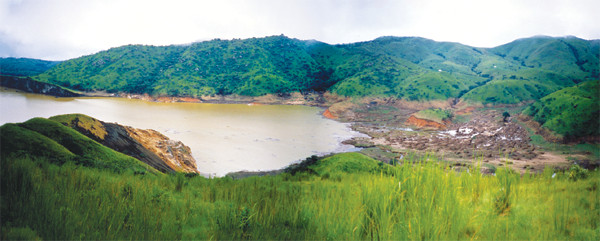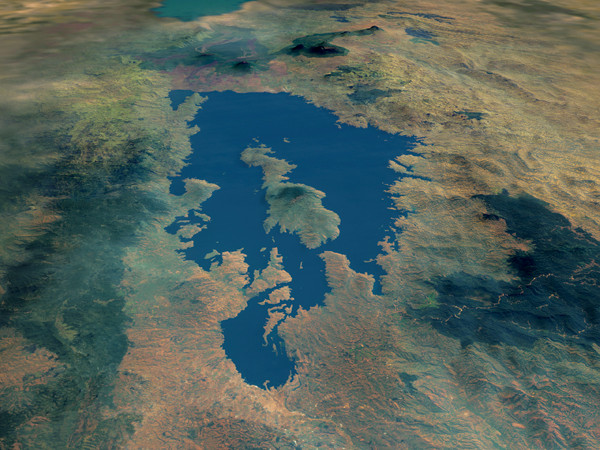
by Sara E. Pratt Monday, August 11, 2014

In August 1986, a carbon dioxide eruption from Lake Nyos in Cameroon killed more than 1,700 people. This photo was taken in early September 1986 by U.S. Geological Survey scientists studying the disaster. Credit: USGS.
Only three lakes in the world are known to explosively release dissolved gases from their bottom waters. All three are in Africa; two have erupted with deadly consequences.
Thirty years ago this month, on Aug. 15, 1984, the bodies of 37 people were found on a road beside Lake Monoun in Cameroon. A massacre was first suspected, then a deadly infectious disease or biological agent. The bodies were quarantined until an investigation could be conducted. Witnesses reported hearing rumbling noises, seeing a white cloud rise from the lake and then dissipate rapidly, and smelling the lingering odor of sulfur, leading officials to suspect a volcanic eruption.
Two years later, on the night of Aug. 21, 1986, another Cameroonian lake, Lake Nyos, erupted, but this time the eruption was much larger. The Nyos eruption killed more than 1,700 people — up to 26 kilometers away from the lake — as well as cattle, wildlife, birds and insects.
Just 100 kilometers away from Lake Monoun, Lake Nyos is also a volcanic crater lake and again, the evidence pointed to a volcanic eruption: Witnesses heard an explosion and reported smelling sulfur. Many of the victims had apparent burns on their skin.
Within months, geologists studying the disaster would discover the real cause, but it would take decades to address the newfound geological hazard.
Before the 1986 eruption, George Kling, a geochemist who was then at Duke University and is now at the University of Michigan, had studied the aquatic biogeochemistry of Lake Nyos, a 208-meter-deep water-filled maar — a deep crater formed by violent steam explosions triggered when magma came into contact with groundwater. (Lake Monoun is also a maar.) After the disaster, Kling returned to investigate along with colleagues, including Bill Evans, a geochemist at the U.S. Geological Survey in Menlo Park, Calif., who studies volcanic lakes. When the team arrived, they found a formerly clear, blue mountain lake that was now muddy red, turbid with sediment and choked by vegetation. Cliffs at the southwestern end of the lake showed the water had exploded to a height of 80 to 100 meters. The southern shore was denuded of vegetation, indicating a 25-meter wave had swamped it. At the northern end, a 6-meter-high wave had overtopped the spillway. A fresh landslide scar was also visible on a slope flanking the lake.
The researchers first suspected the disaster was caused by a gas jet from an erupting submarine volcano. The lakes lie on the Cameroon Volcanic Line, a 1,600-kilometer-long chain of Cenozoic-aged volcanoes running southwest-northeast from offshore in the Gulf of Guinea into Central Africa. So an eruption would have made sense. But the results of their analyses proved inconsistent with a volcanic eruption. At depth, they found clear water, undisturbed sediment, low water temperatures and an absence of sulfur and chlorine compounds — all indications that no major volcanic eruption had occurred. Furthermore, water samples retrieved from the bottom of the lake effervesced upon reaching the surface, indicating the waters were supersaturated with dissolved gas, which analysis showed to be carbon dioxide.
Meanwhile, Haraldur Sigurdsson, a geochemist and volcanologist at the University of Rhode Island, had conducted isotopic analyses of the 96-meter-deep Lake Monoun bottom waters, which were also supersaturated with carbon dioxide. Sigurdsson’s analysis further showed that the carbon dioxide originated, not within a volcano, but a deep magma body.
The researchers concluded that the lakes themselves were the source of the eruptions: rare limnic eruptions.
Kling, Evans and colleagues reported in Science in April 1987 that for decades or even centuries, carbon dioxide-rich gas from deep within the earth had been seeping into groundwater that entered the lakes via submarine springs. Isotopic analysis of surface springs surrounding the lakes, which, according to local lore, often killed frogs and birds, showed a common origin for the spring and lake waters. Depth profiles of the lakes revealed strongly stratified temperature and density layers. Unlike most lakes, which overturn and mix seasonally or annually, such meromictic lakes do not overturn. The perpetual stratification allowed high concentrations of dissolved gas to build up in cold, dense and highly pressurized bottom waters — until a disturbance released the gas.
At Lake Nyos, a recent landslide — which saw hundreds of tons of rock slip into the lake, leaving a fresh scar on the nearby hillside — is thought to have been the likely trigger. The trigger at Lake Monoun has never been determined, but research suggests that when bottom waters reach supersaturation, a number of common lake processes, or even a heavy rainfall, could trigger an overturn.
In total, Lake Nyos released about a cubic kilometer of dense carbon dioxide, which flowed downhill at up to 70 kilometers per hour and settled into valleys surrounding the lake. When comprising more than 10 percent of air, carbon dioxide causes rapid loss of consciousness. The toxic fog suffocated victims who encountered pockets of the heavier-than-air gas, which can’t be seen, tasted or smelled. In the village of Nyos, all but six people died.
Later medical analysis determined that in some cases, upon losing consciousness, victims had fallen onto a heat source, like a cooking stove, and been burned. But the blistered skin of many victims was caused neither by heat nor chemical burns; it was caused by a lack of oxygen to and pressure on the skin, which caused ulcerations similar to bedsores.
Kling has called the timing of the eruptions, both of which occurred in August, just two years apart, intriguing. He has suggested that weakening stratification due to a trend of decreasing air temperatures in the region in the years prior to the explosion along with lake stability normally reaching an annual low in the warm, late summer months, may have been responsible for the events.
In the months after the disaster, an international team of scientists and engineers began working with the Cameroonian government to safely remove the gas from the lakes in the hope of preventing another eruption — but the efforts took time.
In 1990 and 1992, scientists who had researched the lakes met in France and reached a consensus on the mechanism behind the eruptions. In 1997, a committee made up of scientists from Belgium, Cameroon, France, Japan and the U.S. formed the Nyos-Monoun Degassing Project Advisory Committee to help coordinate the project.
In 2001, after years of modeling various methods and considering potential consequences of the forced degassing — and the installation of some test pipes by French researchers to see if degassing could destabilize the stratification in the lake and cause another explosion — the first pipe was sunk into Lake Nyos and continuous degassing successfully began. In 2003, a similar pipe was installed in Lake Monoun. Initially, however, pumping rates were not fast enough to remove the gas and reduce the hazard. A single pipe would have taken 15 years or more to remove the gas, but the team struggled to gain funding for more pipes.
In 2010, funding was secured from the United Nations Development Programme to install two more pipes in Lake Nyos. By 2012, when Kling and Evans and other members of the committee returned to Cameroon to monitor the degassing project, total carbon dioxide in the lake had been reduced by about 40 percent (since 2001) and was still decreasing. At Lake Monoun, where two additional pipes had been added in 2006, they found negligible levels of gas.

Only three lakes in the world are known to build up dangerous concentrations of gas in their bottom waters: Lake Nyos and Lake Monoun in Cameroon and Lake Kivu in Rwanda, shown here. Credit: NASA/Goddard Space Flight Center Scientific Visualization Studio.
On the other side of the continent, however, lies an even larger potential disaster in Lake Kivu, a 2,370-square-kilometer lake on the border of Rwanda and the Democratic Republic of the Congo (DRC). Not only is the lake much larger than Nyos, but it is surrounded by a much larger population of about 2 million people.
The lake straddles a volcanically active rift where hydrothermal saline springs leak both carbon dioxide and methane into the lake’s salty bottom waters, which keeps the lake stratified. An estimated 300 cubic kilometers of carbon dioxide and 60 cubic kilometers of methane are trapped in the lake’s bottom waters.
Although the carbon dioxide concentrations at the bottom of Lake Kivu are lower than those of Lake Nyos, geologic evidence shows the lake has nevertheless erupted before. Robert Hecky, a geologist at the University of Minnesota at Duluth, found evidence of at least five previous eruptions in sediments cored from the lake bottom. Roughly every 1,000 years, high levels of organic matter — dead plants and animals — suddenly sank to the bottom of the lake.
The region also faces the threat of an additional natural hazard that could trigger an eruption. Mounts Nyiragongo and Nyamuragira, volcanoes that last erupted in 2002 and 2010 respectively, lie near the north end of the lake. A lava eruption on the lake bottom, researchers say, could simultaneously overturn the lake’s stratified layers, degas the carbon dioxide and ignite the methane.
There is currently no degassing project underway at Lake Kivu — which, at 485 meters, is much deeper than the Cameroonian lakes. But scientists are working on developing a method to vent both carbon dioxide and methane from the lake.
A 2003 study estimated Lake Kivu holds enough methane to supply electricity to both Rwanda and the DRC for a decade. So far, only small demonstration projects, including a 4-megawatt power plant, have been built. But they have proven extraction is feasible, with one plant successfully supplying power to a local brewery.
© 2008-2021. All rights reserved. Any copying, redistribution or retransmission of any of the contents of this service without the expressed written permission of the American Geosciences Institute is expressly prohibited. Click here for all copyright requests.